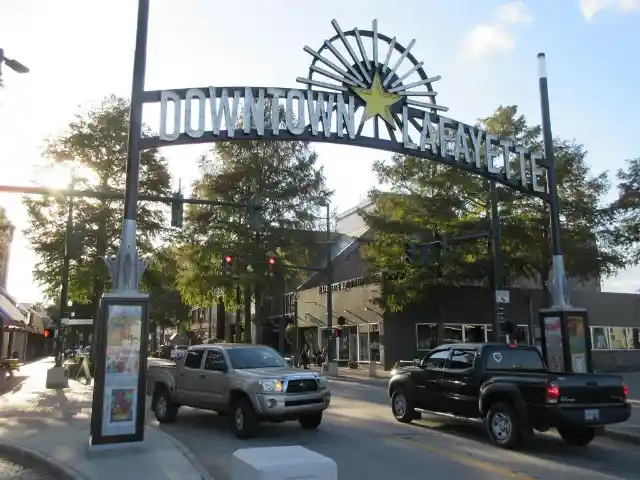Baton Rouge, Louisiana
In the 21st place, back in Louisiana but almost doubling Lafayette's population, is Baton Rouge. Over the past few years, its residents have noticed an increase in the cost of living. They spend on housing 21.59% of the area's median household income.


In spite of this, it is still one of the most affordable places to live. Living in Baton Rouge, the state’s capital city is cheaper than living in metro areas like New Orleans. The average annual salary in the area is $49,260.
Greenville, South Carolina
Back in South Carolina, but 40 minutes east from the previous destination of that state, is Greenville, where only 21.21% of the resident's income is spent on housing. Thanks to its past textile industries, jobs in the area are mainly related to the manufacturing field.


One of the main attractions in the region is enjoying the football games of the rival local universities. The low cost of living in Greenville must be something well known because, between 2016 and 2021, its population grew by 5%.
Huntington, West Virginia, and Ashland, Kentucky
The metro area made up of Huntington and Ashland, known locally as the Tri-State because Ohio is also part of the mix, offers its residents the benefits of a low cost of living. They spend 21.17% of the median annual household income on housing.


Another benefit of this metro area is that the crime rate is lower than in similarly sized metro areas. The average annual salary is $44,400, but people living in one state can decide to work in another and shop in another, depending on what's better for them.
St. Louis
This is Missouri's largest metropolitan area, and it occupies the 25th spot on this list. St. Louis's affordability is more significant than that offered in places of equal or similar size in the U.S.


Living in St. Louis requires 21.7% of the median household income, whereas places like Baltimore and Tampa, Florida, can't match that cost of living. Surprising as it may sound, people seem to be moving out of this metro area instead of moving in.
Spartanburg, South Carolina
The Palmetto State has a lot to offer, from pricey metro areas like Charleston, South Carolina, to less expensive ones like Spartanburg. It is located in the northwestern part of the state, and its residents' outlay on housing is only 21.68% of the area's median annual household income.


Another advantage of living in Spartanburg is that, as it's a less densely populated part of South Carolina, the property taxes are lower than those in the state's coastal areas, which helps lower the cost of living.
Lafayette, Louisiana
Next on the list is the vibrant and culturally diverse state of Louisiana with the city of Lafayette. The cost of living in this area requires 21.68% of the median household income. That fraction comprehends the cost of rent, mortgage payments, property taxes, and utilities.


The education and health care sectors offer great work opportunities. Even though the average annual salary in the area is more than $13,000 below the national average, the low cost of living compensates for this.
Cincinnati
With an average annual salary of $53,650, Cincinnati residents are below the national average of $56,310. However, in Cincinnati, the cost of living is 21.61% of the median household income, which means that Cincinnatians spend less on housing than Lafayette residents.


Regarding Cincinnati's population, there hasn't been any significant change. According to the U.S. Census Bureau, Cincinnati's population has increased by 0.54% between 2016 and 2021.
Scranton, Pennsylvania
Home to the popular series The Office, Scranton is next on the list of affordable places to live. The income spent on living expenses is 21.54%, whereas in larger areas, like Philadelphia, it’s 24.94%.


By looking at the difference in the percentage of income spent on housing, it is easy to tell that Scranton is a less expensive place to live, but it isn't the most affordable in Pennsylvania. The average annual salary in Scranton is $46,230.
Buffalo, New York
Located in the northwestern region of New York, Buffalo ranks really well in terms of affordability; as a matter of fact, the cost of living in the area has been kept low for its residents for quite some time.


People living there spend only 21.46% of the median household income on living expenses. Even though income and property taxes may be high in the state of New York, the costs of health care and utilities are below the national average.
Tulsa, Oklahoma
The low costs of living, the beautiful Art Deco architecture and the Arkansas River are some of the things that make Tulsa a great place to settle down. Residents spend 21.33% on living expenses.


The average annual salary in T-town is $49,800, which allows its residents to live comfortably. Once considered the oil capital of the world, Tulsa still has an active oil industry, but the job market in the area offers more opportunities than that.
Knoxville, Tennessee
Moving to the east, the 17th place is for Knoxville, Tennessee. People may think of Nashville first when they hear about the Volunteer State, but, in terms of affordability, Knoxville wins with a cost of living of 21.24% of the median household income versus 23.8%.


The proximity to the Great Smokey Mountains National Park and the University of Tennessee are great reasons to move to Knoxville, but the real benefit is that buying a home in Knoxville costs less than in other metro areas around the U.S.
Kalamazoo, Michigan
With a population of 264,322, the smallest on this list is Kalamazoo. In case you don't know, this city is located in Michigan, and it is the birthplace of the Gibson Guitar Corporation. The city residents spend 21.22% of the area's median household income.


The average annual salary in the area is $51,480. Residents of Kalamazoo in school-age can benefit from the Kalamazoo Promise and get up to 100% of tuition and mandatory fees paid at any in-state public community college or university.
South Bend, Indiana
South Bend, paradoxically located in the north of Indiana, has low costs of housing, and residents require just 21.06% of the area's median household income to deal with the cost of living. Those living in the area can enjoy river activities like fishing or kayaking.


The job market in South Bend is no longer what it once was. Many of the manufacturing companies that thrived in the 20th century have long gone, but old habits die hard, and the manufacturing presence is still there. The healthcare industry is a significant employer too.
Des Moines, Iowa
Des Moines is Iowa's capital city and has had a low cost of living for years. People living in Des Moines spend 21.03% of their income on living expenses. It is the largest city in the state, and the metro population is 690,585.


The average annual salary is $55,660, slightly below the national average. No matter the sport, people in Des Moines have a wide range of local teams to cheer up for, like the Iowa Cubs, the Des Moines Buccaneers, the Iowa Wolves, and the Iowa Wild.
Grand Rapids, Michigan
Grand Rapids is the second Michigan city in this affordability ranking, with a metro population four times bigger than Kalamazoo's. Compared to the national median, housing costs in Grand Rapids are below it. The income spent on living expenses is 20.71%.


The average annual salary in the area is $49,700, but Grand Rapidians don't spend as much as people in other parts of the country on daily necessities. Establishing in Grand Rapids means affordable housing and tons of recreational activities to do.
Youngstown, Ohio
Located in the northeastern region of Ohio, Youngstown takes us to the last ten cities on the ranking. Although the average annual salary is $43,550, in terms of affordability, Youngstown's cost of living is much lower than in other parts of the country.


Residents of this metro area spend 20.64% of the median household income on housing. Youngstown is a city rich in arts and culture. It is home to the Butler Institute of American Art, the first museum dedicated exclusively to American art.
Peoria, Illinois
Along the bank of the Illinois River, Peoria claims its place on the ranking. Only 20.59% of Peoria's residents' median household income is spent on rent or mortgage, utilities, taxes, and other related costs. For relatively little money, people can buy a nice house.


This metro area has fairs, festivals, or events to celebrate on almost any month of the year, so its 403,747 residents are always entertained. The average annual salary is $2000, below the national average.
Fayetteville, Arkansas
Together with the low cost of living the area provides, it's probably due to the job opportunities people have in Fayetteville that its population grew significantly between 2016 and 2021. Currently, the metro population is 526,101.


The average annual salary is $50,470, and residents spend around 20.56% of their household income on housing costs. The education sector has given employment to many people, but three of Arkansas' commerce giants, which are part of the Fortune 500 companies, have done it too.
Beaumont, Texas
With a lower price than the previous states, Texas gives this ranking the Beaumont metro area. Residents of Beaumont spend on living expenses 20.55% of their incomes. The cost of living in the region is lower than the average cost of living in the nation.


However, residents aren't moving in but out of Beaumont, causing the area's population to shrink by 2.35% between 2016 and 2021. In Texas, particularly in Beaumont, the job market mainly has to do with oil and gas production.
Pittsburgh
Back in Pennsylvania, but for a much more affordable cost than Philadelphia and Scranton, is Pittsburgh. It offers a cheaper housing market than other large cities. Just 20.4% of the resident's household income is spent on utilities and rent or mortgage payments.


Pittsburgh has several professional sports teams, and residents really enjoy it when their teams have a game. The NFL's Steelers, the NHL's Penguins, and the MLB's Pirates can make the whole city stop for a few hours. Steel City's average annual salary is $54,300.
Fort Wayne, Indiana
The cost of living in Fort Wayne is much lower than the national average. Residents in Fort Wayne spend only 20.32% of the median household income on housing expenses. Buying a home is a realistic goal for residents, thanks to the affordable home prices.


The slow growth of the population of the Fort Wayne metro area is one of the reasons why the cost of leaving has remained low. Fort Wayne's population grew by just 1.6% between 2016 and 2021. The average annual salary is $48,060.
Quad Cities – Davenport-Bettendorf, Iowa, and Moline-Rock Island, Illinois
Formed by Davenport and Bettendorf in the state of Iowa and Moline and Rock Island in the state of Illinois is the Quad Cities region. Residents enjoy the low cost of living in the area and spend nothing but 20.24% of the median household income on housing.


Along the banks of the Mississippi river, these cities are affordable options. Residents have an annual average salary of $50,160. Some of the job options people have in the area are in manufacturing, retail, health care, and education.
Huntsville, Alabama
The third place of the most affordable places to live in is Huntsville. This city in the state of Alabama offers its residents low housing costs, making them pay just 20.12% of the median household income.


Huntsville has an average annual salary of $58,730, that's above the national average. The population in this metro area is the most educated in the state. Engineering, aerospace and defense are among the largest job sectors.
Green Bay, Wisconsin
The low cost of living in Green Bay and the below-the-national-average house costs makes it a great place to live. Only 20.03% of the area's median household income is what residents spend on housing. The average annual salary is $50,020.


Home to the NFL's Green Bay Packers, this Alabama city has a lot to offer. Outdoor activities can be enjoyed during summer and winter time equally. Regarding the job market, the health care industry, together with paper and shipping businesses, are the major employers.
Hickory, North Carolina
In the first place, in the state of North Carolina, is Hickory: the most affordable place to live in the U.S. Hickory's metro population is 367,982, and the income spent on living expenses is 19.3% of the median household income.


Hickory residents enjoy a lower cost of living than the more populated parts of the state. Although the average annual salary is $43,630, the median sale price for homes in Hickory is lower than the state average, and rents are low as well.